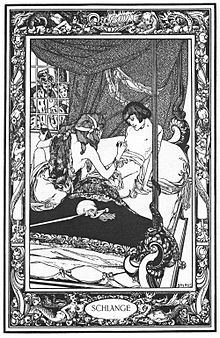The snake (Giambattista Basile)

The snake ( Neapolitan original: Lo serpe ) is a fairy tale ( AaTh 433 B, cf. 425 A, 432). It is in Giambattista Basile 's Pentameron collection as the fifth story of the second day (II, 5).
content
A childless peasant woman adopts a snake from a bundle of brushwood that her husband brings home. She grows up and lets the peasant woo the king's daughter. The king demands that his garden be turned to gold, then the walls to diamond, and finally the palace to gold. The snake lets the farmer sow seeds, shards and herbs, accomplishes everything, the king gives up. Everyone runs away from the groom, only the bride is steadfast. He is shedding his skin and is a handsome man. His parents burn his skin, he turns into a pigeon that flees and bumps blood on the windows. On her search, the daughter meets a vixen who listens to the birds that the prince is being healed by the blood of birds and foxes. The vixen catches the birds and she kills the vixen with cunning. She heals the prince who was cursed in the serpent and preserves him as a man. Only when he recognizes her does he consent when she sees his loyalty.
Remarks
Fertility metaphors such as the “grafting” of brushwood , but also the magical gold seeds, mock the peasant couple. The mythological content of the snake is here conceived in a friendly manner. Compare with Basile II, 2 Verde Prato , II, 9 Der Riegel , V, 4 Der goldene Stamm and already with Straparola König Schwein and Biancabella . The fairy tale was published in German by Jacob Grimm and in 1845 in Hermann Kletke's fairy tale hall , No. 9. Cf. Grimm's fairy tale of the toad , The singing, jumping little lion , Hans my hedgehog , at Bechstein Siebenhaut . Rudolf Schenda names a Hungarian variant in Linda Déghs Hungarian Folktales in addition to Italian . Walter Scherf finds Basile's text inconsistent, the motif of the wages to be shared remains blind.
literature
- Giambattista Basile: The fairy tale of fairy tales. The pentameron. Edited by Rudolf Schenda. CH Beck, Munich 2000, ISBN 3-406-46764-4 , pp. 156-164, 538-539, 588-589 (based on the Neapolitan text of 1634/36, fully and newly translated).
Web links
- Il serpente in modern Italian
- Gutenberg-DE: The snake in German translation (probably after Felix Liebrecht)
- Märchenlexikon.de on AaTh 433 B
- Märchenatlas.de on The Snake
- Staatliche Kunstsammlungen Dresden: Picture by Josef Hegenbarth for Die Schlange
- The Serpent in verse by Laura Bobrow (English)
Individual evidence
- ^ Giambattista Basile: The fairy tale of fairy tales. The pentameron. Edited by Rudolf Schenda. CH Beck, Munich 2000, ISBN 3-406-46764-4 , pp. 588-589 (based on the Neapolitan text of 1634/36, completely and newly translated).
- ↑ Walter Scherf: The fairy tale dictionary. Volume 2. CH Beck, Munich 1995, ISBN 978-3-406-51995-6 , pp. 1019-1021.